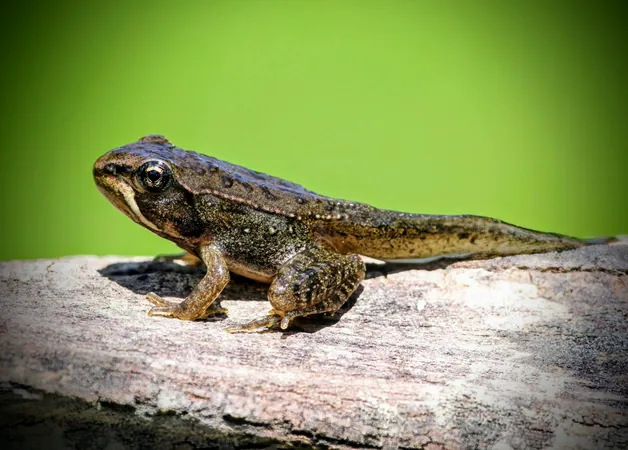
Tadpoles Race Against Time: Accelerating Growth to Outsmart a Deadly Virus
2025-03-30
Author: Li
Amphibians are facing a critical crisis, driven by climate change, pollution, and habitat loss, leading to staggering declines in their populations. Diseases have emerged as an even more silent killer, wreaking havoc from frogs to tadpoles. Alarmingly, since the 1970s, around 200 amphibian species have disappeared, with a staggering 34% of the 7,296 known species currently on the brink of extinction, according to the International Union for the Conservation of Nature (IUCN).
One of the main threats to these creatures is ranavirus, a genus of viruses that spreads rapidly among fish, reptiles, and amphibians. The devastation it causes is significant, particularly for species that lack natural defenses. However, a recent study published in Frontiers in Amphibian and Reptile Science has shed light on the remarkable adaptability of these amphibians.
The research, led by Logan Billet, a PhD student at Yale University, examined the response of wood frog tadpoles (Rana sylvatica) to this lethal virus. Billet noted, “We found that in reaction to ranavirus, wood frog tadpoles alter their growth, development, and how they allocate resources. This strategy may help them cope with the energetic demands of infection or escape from hazardous environments entirely.”
A Devastating Threat
Ranavirus is responsible for an alarming 40% to 60% of amphibian die-offs across the United States. Infected larvae become lethargic, cease feeding, swim erratically, and often experience internal bleeding, leading to widespread fatalities in aquatic habitats. With rising global temperatures, the incidence of such outbreaks is expected to rise.
Focusing on wood frogs, researchers monitored populations across 47 Connecticut ponds from 2021 to 2023. The studies revealed that of these ponds, 35 remained virus-free, seven had low death rates, and five experienced complete die-offs.
Tadpoles Accelerate Growth in Crisis
From mid-April to July, scientists regularly collected tadpoles for analysis, testing their livers for the presence of ranavirus while measuring their growth and developmental stages. Remarkably, tadpoles from ponds that later faced die-offs exhibited faster growth rates and advanced at an astonishing pace of approximately 0.38 stages ahead of their peers in unaffected ponds.
However, once infections began, growth rates plummeted, resulting in smaller, less-developed tadpoles. In contrast, those in infected ponds that avoided total die-offs continued to grow swiftly, eventually reaching developmental stages 1.7 Gosner points ahead of their counterparts in clean ponds.
This accelerated growth in response to ranavirus exposure may be an evolutionary strategy for survival, allowing tadpoles to progress swiftly in their life cycle, thus enhancing their chances of avoiding death.
A Unique Survival Tactic
Dr. David Skelly, the study’s senior author and a professor at the Peabody Museum, explained, “By speeding up growth and reallocating resources early on, tadpoles can enhance their physical condition and immunity in anticipation of infection. They might even metamorphose earlier, escaping the danger posed by ranavirus.”
This research provides insight into why not all amphibian die-offs result in complete population extinction. Billet noted, “These adaptive responses could offer tadpoles a crucial survival advantage, explaining the partial mortality observed in some outbreaks during our study.”
While the study opens new avenues for understanding amphibian resilience in the face of disease, questions remain about how tadpoles detect ranavirus and how effective their adaptive responses are in enhancing survival or tolerating infections. Future controlled experiments will be pivotal in addressing these inquiries.
In summary, this study highlights the dynamic responses of amphibians, particularly wood frogs, as they strive to survive in a world increasingly affected by human activities and climate change. As we witness these shifts in their survival strategies, the fate of our planet’s biodiversity hangs in the balance, with the narrative of wood frogs and their fight against ranavirus only beginning to unfold.





 Brasil (PT)
Brasil (PT)
 Canada (EN)
Canada (EN)
 Chile (ES)
Chile (ES)
 Česko (CS)
Česko (CS)
 대한민국 (KO)
대한민국 (KO)
 España (ES)
España (ES)
 France (FR)
France (FR)
 Hong Kong (EN)
Hong Kong (EN)
 Italia (IT)
Italia (IT)
 日本 (JA)
日本 (JA)
 Magyarország (HU)
Magyarország (HU)
 Norge (NO)
Norge (NO)
 Polska (PL)
Polska (PL)
 Schweiz (DE)
Schweiz (DE)
 Singapore (EN)
Singapore (EN)
 Sverige (SV)
Sverige (SV)
 Suomi (FI)
Suomi (FI)
 Türkiye (TR)
Türkiye (TR)
 الإمارات العربية المتحدة (AR)
الإمارات العربية المتحدة (AR)